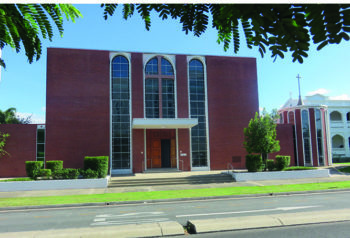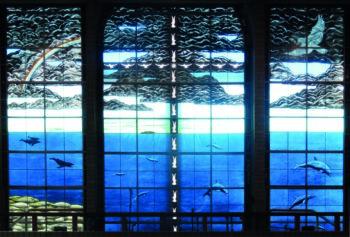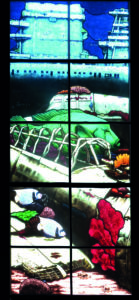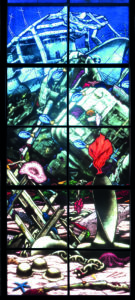Cairns Cathedral – Bucket List Item

By Glen McCullogh
Several friends who had been to Cairns told me that the stained glass windows were superb. So I put it on my ‘bucket list’. The chance finally came to fly there after a road trip with friends that ended in Brisbane.
The Cathedral of St Monica was easy to find, prominently placed on the edge of Cairns CBD. It was constructed in the late 1960’s as a war memorial, commemorating the Battle of the Coral Sea in May 1942.
As I entered the church, my first reaction was “Wow!” The effect of all the coloured windows running the length of both sides gives the church a very rich and colourful ambience. Then I started to look at the windows, and found that while they are not conventional stained glass windows, they are very beautiful. There are too many to show here, but an appropriately numbered sample will suffice.

Starting from the right front facing the altar, they tell the story of creation through 12 windows on the right side and 12 on the left side. Starting with the nothingness of space [1], the creation of light [2], and our solar system [5]. Land and sea [9], fish [12] animals [15], birds [16], and humanity [18] followed. Finally, there is the descent to the end of the world as told in the Book of Revelation [22-24].

[1]

[2]

[5]

[9]

[12]

[15]

[16]

[18]

[22]

[23]

[24]
Behind me, above the entrance, were three windows installed in 1995 following the 50th anniversary of the Battle of the Coral Sea, which was fought due east of Cairns in May 1942. To quote from the leaflet provided by the Cathedral:
The Battle of the Coral Sea was the first in naval history in which ships did not fire at each other. It was a battle of aircraft carriers and aircraft. As such it became a precursor to modern-day missile warfare. Troops stationed in Cairns and the Tablelands recall seeing glowing flashes reflected over the horizon at night during the fierce battle.
The ‘Peace’ window below shows the smoke of burning ships, with the Holy Spirit as a dove and a rainbow symbolising peace. The central cross is made up of playful doves -- the Holy Spirit at work and play. The frolicking undersea life is unaffected by what happened above the waves, and also represents peace.

The two windows below are scenes at the bottom of the Coral Sea. The right, labelled ‘Chaos & Crucifixion’, shows two sunken warships. At the bottom is a rifle with coral growing from the barrel, with three soldiers’ helmets (American, Japanese, Australian). The crucifixion is represented by the three radio masts on top of the wrecked ship, forming a reminder of Calvary. The left window, labelled ‘Rest & Resurrection’, shows an aircraft carrier, the USS Lexington, the aircraft flown by the only Australian killed in the battle, and a Japanese dive-bomber of a type used later in the war by kamikaze pilots. As an ex-aircrew member, I did not see anything other than death, waste of life and destruction - a similar feeling to that I experienced in Commonwealth War Cemeteries in Europe when confronted by aircrew graves. I certainly did not see anything restful in it, except perhaps in comparison to the one on the other side.

Rest & Resurrection

Chaos & Crucifixion
After finishing photographing them all, I sat at the back and was overcome by the need to thank God for the privilege of being in this beautiful, light-filled cathedral, for my good health, and for being loved by Him.
 Entries(RSS)
Entries(RSS)